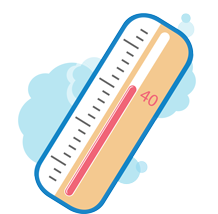Toddler Bath Time Guide
Playing in the bath with your toddler and providing her with lots of props like pitchers, cups and books boosts her learning and nurtures her bond with you. Watch this video for a step-by-step guide on how to make toddler bathing fun
Your toddler develops self-confidence when she can take care of herself and her ducky, and when she figures out how to pop the bubbles. Her thinking skills are boosted as she uses her imagination while playing pretend, and when she makes connections between what she sees in books and her own “real” life. She builds language skills and the muscles in her fingers and hands when she turns the pages of the book and learns new words as you read together.
Social-Emotional Development
What you can do
Ask your toddler if she’d like to try washing herself.
Delight in your toddler’s discoveries and accomplishments. Let her know what a good job she does, for example, cleaning and taking care of her ducky.
Help her cope with transitions by giving her notice before bathtime ends and letting her take a favorite toy with her.
What your child is learning
That she can take care of herself and that she is a good helper.
That she is important and capable.
That her feelings are important and that you will help her manage difficult situations.
Language and Thinking Skills
What you can do
Explore bath books together. Invite her to point to familiar objects. Show her the connection between what she sees in the book and things in her “real” world.
Talk with your toddler about what you are doing together during bathtime. Ask her questions: Is ducky thirsty? Does ducky need to get washed?
Help your toddler become a good problem-solver; for example, by guiding her in how to soap up the sponge or find the page she’s looking for in her book.
What your child is learning
New words and to love books and reading, anytime, anywhere.
That she is a good communicator. That she can develop her own ideas.
That she can tackle the challenges she faces.
Physical Development
What you can do
Offer your toddler lots of different safe objects to explore in the bath.
Notice the way she uses her body to make things happen, like popping the bath bubbles.
What your child is learning
How to use her fingers and hands to make things work, such as grasping the pitcher firmly and dunking it in the water before pouring.
That she has a good, strong, body that can do so many great things. This builds positive self-esteem.

Remember, ensuring toddler bath safety is the number one priority. NEVER leave a baby alone in the bath. Not even for a second. So gather all the things you will need for the bath beforehand
and if the phone rings, just let it. Also, be sure to set your water heater below 37 degrees Celsius to help prevent the possibility of scalding.
Moms around the world trust JOHNSON’S® to care for their babies
We are committed to working with moms, healthcare experts and scientists to ensure our products continue achieving the highest JOHNSON’S® baby standards.
Learn how we're making JOHNSON’S® products even better for your baby >
Baby Bedtime
Join Elle Walker as she debunks common MythConceptions about baby sleep

